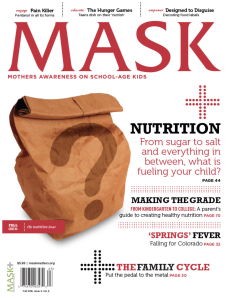
The Importance of Character Education in Schools
February 2, 2024
Helping Kids Navigate Peer Pressure
February 7, 2024Types of Common Eating Disorders
Introduction:
Eating disorders are serious but treatable mental illnesses that can be debilitating. They occur when a person’s relationship with food and body image becomes unhealthy. Eating disorders are not just about food, but rather how we feel about ourselves. They also aren’t just for girls—boys and men can also develop eating disorders too! While everyone talks about anorexia, bulimia, binge eating disorder (BED), orthorexia nervosa or other types of eating disorders, there are many different types of eating disorders out there that go undiagnosed or misunderstood by the general public.
Anorexia Nervosa:
Anorexia nervosa is an eating disorder that is characterized by excessive weight loss, a distorted body image, and an intense fear of gaining weight.
It can be a serious mental illness that can be fatal if left untreated. Also if you have diabetes along with anorexia or any other eating disorder then it’s high time that you run to a doctor and get yourself checked.
Binge Eating Disorder (BED):
Binge eating disorder (BED) is a type of eating disorder that’s characterized by recurrent binge eating episodes in which the person feels out of control while eating, and continues to eat even though they are uncomfortably full. Binge eating episodes are followed by intense feelings of guilt, shame, or depression.
BED is often associated with obesity, but not all people who have this condition are overweight or obese; some may be normal weight or underweight. Although they may feel ashamed about their bingeing behavior and try to hide it from others, individuals with BED usually know when their appetite has gotten out of control because they’ve experienced feelings of fullness after only one or two meals at most–a sign that most other people wouldn’t experience until after three or four meals!
Bulimia Nervosa:
Bulimia nervosa is an eating disorder characterized by cycles of bingeing and compensatory behaviors such as self-induced vomiting, excessive exercise or fasting. People with bulimia nervosa will often feel out of control while they are binging on food, which can lead to shame and guilt afterwards. Bingeing is defined as consuming a large amount of food in a short period of time (usually within two hours), whereas purging occurs after the bingeing has occurred.
Bingeing and purging are not the only symptoms associated with bulimia nervosa; there are also other signs that may indicate whether someone has this condition:
- Feeling depressed or having low self-esteem
- Having problems with concentration or memory loss
You should consult your doctor if you are suffering from bulimia and should start taking best multivitamins on your dietician’s prescription to avoid malnourishment!
Avoidant/Restrictive Food Intake Disorder (ARFID):
If you have ARFID, you may be afraid to eat in front of others or may worry about how much food is on your plate. You might also worry about what other people think about the way you look and act. If this sounds like something that might apply to you, take a look at some of these symptoms:
- Avoiding eating certain foods because they’re “bad” or “unhealthy.” This can include avoiding all fats or carbohydrates (like breads), all sweets or any food with sugar in it–even fruit! It could also mean skipping meals altogether because they aren’t worth the calories they contain.
- Dislike of eating in public places such as restaurants or cafeterias where other people are eating around them too. They may even avoid going out altogether if they know there won’t be anything available that fits their dietary restrictions at any given location (for example: vegetarian restaurants).
Night Eating Syndrome (NES):
Night eating syndrome (NES) is a disorder that affects people of all ages, but it’s most common in young adults. NES is characterized by eating after the evening meal has ended and may lead to weight gain, disrupted sleep patterns and depression.
Many people with NES don’t realize they have the condition until they begin to gain weight or have trouble falling asleep at night. If you think you might have NES, talk to your doctor about treatment options for this condition.
Orthorexia:
Orthorexia is a type of eating disorder where someone becomes obsessed with eating healthy food, and becomes anxious if they eat something that isn’t healthy. It can be hard to tell whether someone has an eating disorder or just has an obsession with healthy eating. People who have orthorexia may feel guilty when they eat unhealthy foods, and they might even punish themselves by refusing to eat anything but vegetables at dinner time (or whatever their version of “normal” meals is).
Orthorexia is similar to other types of eating disorders in that it causes people’s lives to revolve around food; however, instead of focusing on weight loss or body image issues like other types of disorders do, those suffering from orthorexia tend to focus on health benefits instead. For example: instead of restricting carbohydrates because they want to lose weight fast (and then gaining it back later), those suffering from this condition will choose low-carb options because they believe these foods are better for them overall–and if anyone tries telling them otherwise? Well then maybe you should go read up on nutrition labels yourself before criticizing others’ choices!
Have compassion for friends and family with eating disorders:
If you have a friend or family member who has an eating disorder, it can be hard to know how to help them. It’s important not to judge them for their choices, but rather than try and “fix” them or tell them what to do. Instead of judging your loved ones with an eating disorder, show compassion by listening and supporting them in any way possible.
Conclusion
Eating disorders are very common and can affect anyone, including friends and family members. Eating disorders are serious mental illnesses that can lead to death if they go untreated. If you think someone has an eating disorder, it is important to get them help right away. Remember that there are many different types of eating disorders and they all require different types of treatment approaches so keep this in mind when seeking out treatment options for yourself or someone else who may need some help getting better!
//Emily John
Grab the Nutrition Issue of MASK The Magazine and learn how to help your child.
MASK The Magazine is the parenting manual offering solutions to the modern-day challenges families face. Each quarterly issue of the award-winning MASK The Magazine tackles a specific topic in-depth and examines how it can affect kids from Pre-kindergarten to College.
MASK the Magazine content is evergreen as it is written based on the “core” topics and strategies. Ships only in the United States.
To learn more about MASK The Magazine



